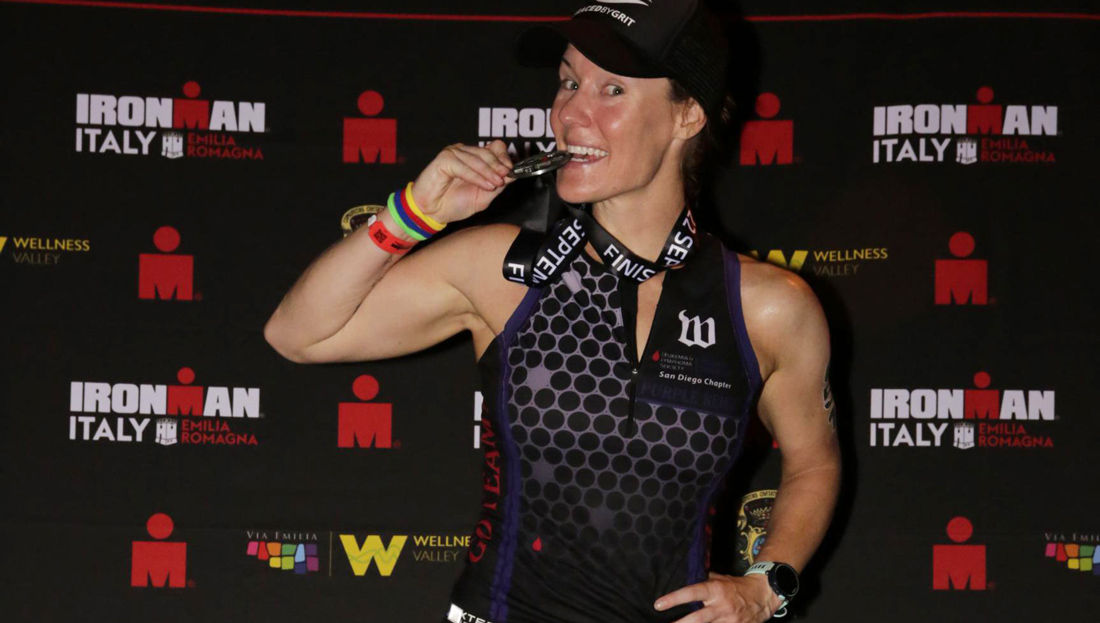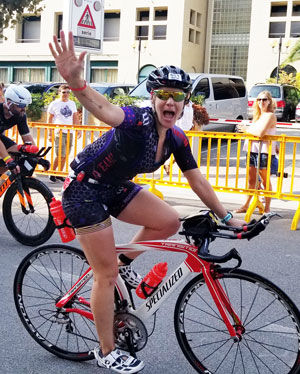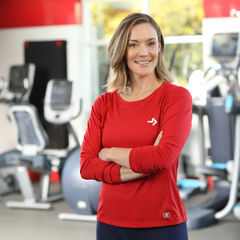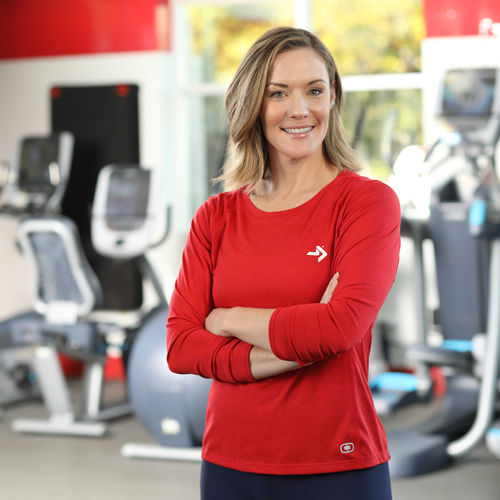
For ACE Exercise Physiology Content Manager Jacque Crockford, becoming an Ironman was a lifelong goal. With her knowledge of endurance training and experience as a long-time triathlon coach, she reached the finish line. If your clients want to take their endurance goals to the next level, this two-part series describes the preparation and factors involved in training for, competing in, and recovering from an Ironman. In Part 2, Crockford describes her race-day tactics and mindset and how she recovered from this extreme event.
The During: Race Day
With a six-month plan that included the mileage needed to cover the Ironman distance, the nutrition plan in place to avoid bonking and a recovery plan to maintain my health both physically and mentally, I was ready to take on the day. With my training partners and support crew, I flew to Cervia, Italy, for the Emilia-Romania Ironman 140.3 race. My goals for the race was to come in under 13 hours and to improve all parts of the race compared to my first Ironman. These were my goal times for each component:
Swim: 1 hour, 10 minutes
Transition 1: 10 minutes
Bike: 6 hours, 30 minutes
Transition 2: 10 minutes
Run: 5 hours
Total: 13 hours
Swim
For this race, the swim component is 2.4 miles in the open waters of the Adriatic Sea. I knew it would be salty (which helps with buoyancy) and warm. Although it was 0.3 degrees Fahrenheit more than the Ironman guidelines for a wetsuit legal race, it was determined the morning of the race that wetsuits would be allowed due to the high number of jellyfish in the swim area. These rhizostoma pulmo, or barrel jellyfish, are up to few feet wide with a purple-blue ring around their umbrella. Although not poisonous, they do leave a sting, which I learned firsthand about 500 yards into the swim.
With a goal swim time of less than 1 hour and 10 minutes, I had trained to swim at about a 1:40/100 yd pace. Despite the run-in with the jellyfish, there was a bit of current from the other swimmers, which helped pull me through the course and around the bouys (similar to drafting on a bike). I came out of the first loop of the swim in very good shape, with an average of 1:33/100 yd, according my Garmin watch. On the second loop, it was a bit harder to navigate around other swimmers, as we came to bottlenecks around each turn buoy. (Official race time: 1:05.57; Garmin time: 1:06.04)
Transition #1
Ironman Emilia-Romagna is famous for one of (if not the) longest transition areas in the Ironman circuit. At nearly 1 mile long, I had to run from the swim exit (where I took a spill into the sand as I tried to regain my land legs), 500 yards up the beach to finally reach the entrance to transition. Transition bags are strategically placed for an easy grab on the go and I made my way into the changing tent. Seventy-five percent of the racing field in this event were men, so the women were allotted just half of one changing tent, while 1.5 tents were reserved for the men. In reality, it turned into a unisex area with all the racers coming through trying to get their land legs back after the 2.4-mile swim. I used my extra water bottle to rinse off the sand and salt and put on my bike jersey (with my nutrition already placed in the pockets), helmet, glasses and shoes and ran the rest of the long transition area to find my bike. (Official T1 transition time: 8:39; Garmin time: 8:32)
Bike
 Coming out of the first transition is always a bit like herding cattle, as everyone tries to quickly jump on a bike in a narrow shoot before heading out on to the open road. Once I made my way out of the transition bottleneck, I settled in and began to warm up my legs with a low gear and quick RPMs. The two-loop course took me and more than 2000 other athletes through small Italian towns and salt fields, and up a final climb to a literal castle on the hill (just like the Ed Sheeran song) overlooking the vineyards. Riding through the curvy narrow cobblestone streets felt like being in the “Tour de France” and the weather was so perfect, I’ve almost forgotten how much the final climb hurt (almost).
Coming out of the first transition is always a bit like herding cattle, as everyone tries to quickly jump on a bike in a narrow shoot before heading out on to the open road. Once I made my way out of the transition bottleneck, I settled in and began to warm up my legs with a low gear and quick RPMs. The two-loop course took me and more than 2000 other athletes through small Italian towns and salt fields, and up a final climb to a literal castle on the hill (just like the Ed Sheeran song) overlooking the vineyards. Riding through the curvy narrow cobblestone streets felt like being in the “Tour de France” and the weather was so perfect, I’ve almost forgotten how much the final climb hurt (almost).
I took the advice of coach Erinne Guthrie, certified USA Triathlon coach and owner of Full Circle coaching in Miami, Fla., and Justin Robinson, USAT Certified Coach, registered dietitian, Board Certified Specialist in Sports Dietetics and Certified Strength and Conditioning Specialist, and used the time on the bike to refuel after the swim, hydrate and fuel more to prepare myself for the last leg of the race (the marathon).
The last 10 miles of the bike seemed to drag on forever as I crossed the salt flats for the second time with an increase in wind speed due to the later hour. This was where I began to tap into all my mental training to stay focused on the task at hand. I used the mantra, “Just move forward,” as the wind slowed me to a speed of 15 miles per hour (I topped out at more than 33 mph during the recovery from the hill climb). One of my goals for this race was to feel better both physically and mentally as I pulled into transition off the bike and, as you can see from this photo, I was clearly very happy to be getting off the bike. (Official race time: 6:28.50; Garmin time: 6:29.03)
Transition #2
As I happily came into transition for the second time, I felt much better physically than I did during my first attempt at the Ironman distance and was ready to tackle the run. But first I had to wind my way back through the mile-long area now scattered with bikes, water bottles, shoes and athletes feverishly trying to remember what to do next. I was able to make it out in a much better time than my first race and was off on the run. (Official T2 time: 7:34; Garmin time 7:14)
Run
I had 5 hours and 9 minutes remaining to finish a marathon if I was going to beat my goal time of 13 hours. As many coaches will tell you, the run is where you become an Iron(wo)man. As performance coach Sam Berry explains, “The adaptations happening to the body on race day during an Ironman competition are several-fold. The endocrine system has significant amounts of epinephrine, norepinephrine and cortisol coursing through the blood facilitated by the sympathetic nervous system. There are considerably high levels of fluid exchange with the loss of fluid in the form of sweat and through glycolysis. Typically, the average fluid loss in an Ironman race is 3% of total body mass. If there are higher percentages of mass lost, there are often performance decrements associated. Those decrements include decreases in power and cognition, hyponatremia and the inability to complete the competition.”
Throughout my training, I worked to get faster on the run by incorporating speed work and higher-intensity sets after I had achieved a solid aerobic base. This proved helpful, and I was able to maintain a faster overall average speed compared to my last race (approximately 11 min/mile). Ironman Italy featured a 4-loop run course, which helped me not only during my preparation to execute long runs based around the same loop a few times, but also for fueling and hydration purposes. Dehydration, of course, is important to consider and for me, as a salty sweater, hyponatremia is also a concern. Hyponatremia is the dilution of cellular fluid when too much water without enough electrolytes is consumed. This is something I’ve practiced dealing with throughout my years as an athlete. Hyponatremia can be very dangerous, as it can cause significant cellular damage. My most frequent side effect of being overly hydrated is a terrible headache. As a proactive measure, I kept electrolyte tabs in my water throughout the race and made sure to continue to drink a full bottle each loop (every 6.2 miles).
The run, although grueling after the long swim and bike, is really where a lot of the magic of Ironman occurs. I met people from all around the world (American athletes made up about 1% of the 2,382 competitors) and was able to pick up on new languages and motivational techniques. For example, Italian race spectators often chant the word “dai” during a race. Of course, what I heard was “die,” which felt very confusing until I learned along the course that the colloquial translation is “Come on” or “Let’s go.”
The Finish Line
The finish line of an Ironman race is, in my opinion, one of the greatest scenes in all of sport. There are lights, music and languages to inspire you all the way to the finish line—and you’ll need it. I had been checking my watch periodically during the race to ensure I stayed somewhat on track with my goal time. As I came into the last turn before the last mile, I looked to see how long I had before I reached the 13-hour mark. Amazingly, I still had 15 minutes! Right then I knew that all the training had been worth it. The hours of long bike rides and runs, the early morning swims and all the days of back-to-back-to-back training sessions were worth it, and my goal was going to be achieved at the finish line.
As I neared the Ironman village, I could hear the music and the lights welcoming me home. During that last mile, all the pain of the day—a sore forearm from my jellyfish encounter, a tight hamstring just after getting onto the bike, and the sore feet from miles and miles of running on cobblestone—faded away and a surreal sensation of floating with the speed of an Olympic athlete came over me. As I stepped on to the red carpet (Ironman welcomes you home in style), the race announcers called me out and welcomed me to the finish line with an official time of 12:53.39 (more than 6 minutes faster than my stretch goal and more than an hour and 10 minutes faster than my previous Ironman time). With tears in my eyes, I stepped over the line and raised my arms in victory. I did it!
As a race finisher, a medal is placed on your neck just you cross the finish line. I was given mine by an elderly Italian man, who saw me crying. With a thick accent, he reassured me: “You no cry. You are Ironman!” Yes, yes I am.
The After: The Recovery
Because of the physical effort that takes place over the course of a training season and on Ironman race day, a few interesting responses take place in the body. As mentioned in part 1 of this series, sleep can be elusive and, although I woke up at 4 am to eat a full breakfast and prepare for the long day ahead, I finished my race around 9 pm and was unable to sleep until about 2 am, with restlessness in both my legs and my mind.
To continue the recovery process when I woke the next day, nutritional therapy was in order. To give an idea of the total caloric intake of the race day, here’s a breakdown of what I took in:
- Breakfast: ~1,000 calories (bagel with peanut butter and jelly, banana, two eggs and GU Roctane drink mixed with water)
- Pre-race snack: ~200 calories (banana and mini Clif bar, plus electrolytes in water)
- Bike nutrition: ~2,000 calories (three bottles of GU Roctane, three Clif bars, four bananas and electrolytes mixed in three bottles of water)
- Run nutrition: ~ 500 calories (GU chews, one Clif bar and electrolytes mixed in four bottles of water)
- Total calories: ~3,700 calories
I also had a small serving of pasta and fruit after the race with more water and electrolytes (~500 calories). According to my Garmin data, I used nearly 6,000 calories during the course of the day, so I was in an energy deficit, but by only about 1,500 calories. A healthy and hearty breakfast was in order the day after the race.
“It takes a good while for an athlete’s body to recover from the extreme stress an Ironman competition puts on it,” explains Berry. “One way to facilitate a speedier recovery is through cold therapy modalities.” In their systematic review and meta-analysis on cold-water immersion and muscle soreness, Machado and colleagues (2016), reported that cold water immersion is more effective than passive recovery on immediate and 24-hour perceived soreness. The researchers recommend water temperatures be between 52 and 59 degrees Fahrenheit (11 and 15 degrees Celsius) for durations of 10 to 15 minutes. I took this advice to heart and made use of the hotel spa the day after the race and took ice therapy baths and eucalyptus showers.
As the effects of the race took hold (including a very sore heel from running on cobblestone), I continued to listen to the advice of all those I consulted for this article and enjoyed my recovery time by traveling through the country that made me an Iron(wo)man for the second time. I am forever grateful to those who contributed to my training (and this article), for their care and support over the years and especially through this successful Ironman experience.
Editor’s note: While Jacque currently has no plans to compete in another Ironman, she’s already started training for her next challenge: a trip to Everest Base Camp to support the Leukemia and Lymphoma Society.

 by
by 

 Coming out of the first transition is always a bit like herding cattle, as everyone tries to quickly jump on a bike in a narrow shoot before heading out on to the open road. Once I made my way out of the transition bottleneck, I settled in and began to warm up my legs with a low gear and quick RPMs. The two-loop course took me and more than 2000 other athletes through small Italian towns and salt fields, and up a final climb to a literal castle on the hill (just like the Ed Sheeran song) overlooking the vineyards. Riding through the curvy narrow cobblestone streets felt like being in the “Tour de France” and the weather was so perfect, I’ve almost forgotten how much the final climb hurt (almost).
Coming out of the first transition is always a bit like herding cattle, as everyone tries to quickly jump on a bike in a narrow shoot before heading out on to the open road. Once I made my way out of the transition bottleneck, I settled in and began to warm up my legs with a low gear and quick RPMs. The two-loop course took me and more than 2000 other athletes through small Italian towns and salt fields, and up a final climb to a literal castle on the hill (just like the Ed Sheeran song) overlooking the vineyards. Riding through the curvy narrow cobblestone streets felt like being in the “Tour de France” and the weather was so perfect, I’ve almost forgotten how much the final climb hurt (almost).
